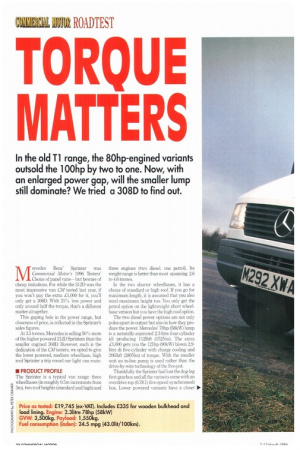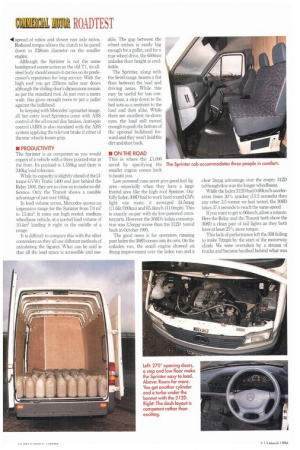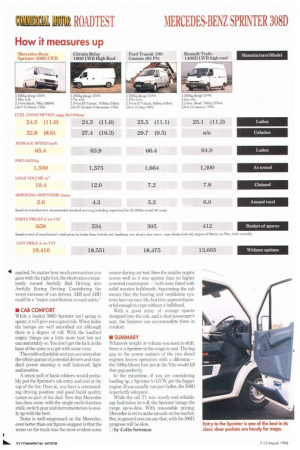1 1 J112. ROADTEST
Page 30

Page 32

Page 33

Page 34

If you've noticed an error in this article please click here to report it so we can fix it.
In the old Ti range, the 80hp-engined variants outsold the 100hp by two to one. Now, with an enlarged power gap, will the smaller lump still dominate? We tried a 308D to find out.
Mercedes Benz' Sprinter was Commercial Motor's 1996 Testers' Choice of panel vans—but beware of cheap imitations. For while the 312D was the most impressive van CM tested last year, if you won't pay the extra £1,000 for it, you'll only get a 308D. With 25% less power and only around half the torque, that's a different matter altogether.
This gaping hole in the power range, but closeness of price, is reflected in the Sprinter's sales figures.
At 3.5 tonnes, Mercedes is selling 50% more of the higher powered 312D Sprinters than the smaller engined 308D. How-ever, such is the dedication of the CM testers, we opted to give the lower powered, medium wheelbase, high roof Sprinter a trip round our light van route.
• PRODUCT PROFILE The Sprinter is a typical van range: three wheelbases (in roughly 0.5m increments from ! 3m), two roof heights (standard and high) and three engines (two diesel, one petrol). Its weight range is better than most spanning 2.6 to 4.6 tonnes.
In the two shorter wheelhases, it has a choice of standard or high roof. If you go for maximum length, it is assumed that you also need maximum height too. You only get the petrol option on the lightweight short wheelbase version but you have the high roof option.
The two diesel power options are not only poles apart in output but also in how they produce the power. Mercedes' 78hp (58kW) lump is a naturally-aspirated 2.3-litre four-cylinder idi producing 1121bft (152Nm). The extra £1,000 gets you the 121hp (90kW) blown 2.9litre di five-cylinder with charge cooling and 2061bft (280Nm) of torque. With the smaller unit an in-line pump is used rather than the drive-by-wire technology of the five-pot.
Thankfully the Sprinter had lost the dog-leg first gearbox and all the variants come with an overdrive top (0.78:1) five-speed synchromesh box. Lower powered variants have a closer spread of ratios and slower rear axle ratios. Reduced torque allows the clutch to be pared down to 228mm diameter on the smaller engine.
Although the Sprinter is not the same bombproof construction as the old T1, its allsteel body should ensure it carries on its predecessor's reputation for long service. With the high roof you get 235mm taller rear doors although the sliding door's dimensions remain as per the standard roof. At just over a metre wide, this gives enough room to put a pallet against the bulkhead.
In keeping with Mercedes' upmarket image, all but entry level Sprinters come with ABS control of the all-round disc brakes. Anti-spin control (ABD) is also Standard with the ABS system applying the relevant brake if either of the rear wheels looses grip.
• PRODUCTIVITY
The Sprinter is as competent as you would expect of a vehicle with a three pointed star at the front. Its payload is 1,550kg and there is 340kg load tolerance.
While its capacity is slightly ahead of the (3tonne GVW) Trafic 1400 and just behind the Relay 1800, they are so close as to make no difference. Only the Transit shows a useable advantage of just over 100kg.
In load volume terms, Mercedes quotes an impressive range for the Sprinter from 7.01113 to 13.41113. It rates our high roofed, medium wheelbase vehicle, at a quoted load volume of 10.4m3 landing it right in the middle of a range.
It is difficult to compare this with the other contenders as they all use different methods of calculating the figures. What can be said is that all the load space is accessible and use
able. The gap between the wheel arches is easily big enough for a pallet, and for a rear wheel drive, the 650nun unladen floor height is creditable.
The Sprinter, along with the Sevel range, boasts a flat floor between the load and driving areas. While this may be useful for bus conversions, a step down to the bed acts as a restraint to the load and dust alike. While there are excellent tie-down eyes, the load still moved enough to push the bottom of the optional bulkhead forward and they won't hold the dirt and dust back.
• ON THE ROAD
This is where the £1,000 saved by specifying the smaller engine comes back to haunt you.
Low powered vans never give good fuel figures—especially when they have a large frontal area like the high roof Sprinter. Our fully laden 308D had to work hard round CYVis light van route: it averaged 24.5mpg (11.61it/100km) and 65.4km/h (41.0mph). This is exactly on-par with its low-powered counterparts. However the 3080's laden consumption was 3.5mpg worse than the 312D tested back in October 1995.
The good news is for operators running part laden the 308D comes into its own. On the unladen run, the small engine showed an 8mpg improvement over the laden run and a clear 3mpg advantage over the empty 3120 (although this was the longer wheelbase).
While the laden 3120 had 0-80krn/h acceleration times 30% quicker (15.2 seconds) than any other 3.5 tonner we had tested, the 308D takes 374 seconds to reach the same speed.
If you want to get to 96ktn/h, allow a minute. Here the Relay and the Transit both show the 308D a clean pair of tail lights as they both have at least 25% more torque.
This lack of performance left the 308 failing to make 70mph by the start of the motorway climb. We were overtaken by a stream of trucks and became baulked behind what was possibly the only vehicle on the road slower than the 308D.
Restarting a 308D from a standstill was only possible if the gradient was below 25% (1-in-4) the 312 managed the 33% (1-in-3) without a problem.
This is not to say the 308 is a bad van-on the contrary, it is a very good one-but its engine struggles when fully laden. Reduce the load and most of the problems disappear.
Loaded, there is a tendency to snatch gears in the under-powered 3081). The first-to-second shift needs time: go too quick and the change is rough. Take time and it becomes far smoothen
Regardless of the state of load, gearboxiengine matching is not ideal. Between 1,6(X)rpm and about 1,900rpm, the drivetrain vibrates badly. While this is below peak torque, it should be a useable engine speed when plodding though built up areas. However at 30mph, fourth gear leaves the engine spinning at about 1,800rpm, which soon persuades the driver to drop a gear to stop the vibration. This adds 700rpm and doesn't do that much for fuel consumption.
While the brakes work well (averaging about 60%g on a wet track) they take a little getting used to. If you really try, you can push
the pedal almost to the floor although by then it has long lost its relationship to the braking effort.
ABD is Mercedes' version of anti-spin could it stand for Awfully Bad Driving?), which comes as the flip side of the standard anti-lock brakes.
While the van was on test it snowed, so we indulged in some ABD: hard acceleration on quiet roads and foot down on the bends even with adverse cambers. The electronics worked very impressively. Every time a rear wheel even thought about breaking away, the light flashed on as the brake was automatically ■ applied. No matter how much provocation you gave with the right foot, the electronics competently turned Awfully Bad Driving into Awfully Boring Driving. Considering the worst excesses of van drivers, ABS and ABD could be a "major contribution to road safety."
III CAB COMFORT While a loaded 3081) Sprinter isn't going to sprint, it will give you a good ride. When laden the bumps are well smoothed out although there is a degree of roll. With the loadbed empty things are a little more taut but not uncomfortably so. You don't get the kick in the base of the spine you get with some vans.
The multi-adjustable seat can accommodate the whole gamut of potential drivers and standard power steering is well balanced, light and positive.
A straw poll of bank robbers would probably put the Sprinter's cab entry and exit at the top of the list, Once in, you have a commanding driving position and good build quality comes as part of the deal. Now that Mercedes has done away with the single multi-function stalk, switch gear and instrumentation is easily up with the best.
Noise is well-suppressed on the Mercedes, even better than our figures suggest in that the water on the track was the most evident noise source during our test. Here the smaller engine scores well as it was quieter than its higher powered counterpart both were fitted with solid wooden bulkheads. Separating the cab means that the heating and ventilation systems have an easy life, but they appeared powerful enough to cope without a bulkhead.
With a good array of storage spaces designed into the cab, and a dual passenger's seat, the Sprinter can accommodate three in comfort.
• SUMMARY Whatever weight or volume you need to shift, there is a Sprinter in the range to suit. The big gap in the power outputs of the two diesel engines leaves operators with a dilemmathe 100hp blown four pot in the Vito would fill that gap perfectly In the meantime, if you are considering loading up a Sprinter to GVW, get the bigger engine. If you usually run part laden, the 308D is perfectly adequate.
While the old T1 was sturdy and reliable, age had taken its toll; the Sprinter brings the range up-to-date. With reasonable pricing, Mercedes is set to make inroads on the market. But, in general you can say that, with the 3081), progress will be slow.
7 by Colin Sowman Price as tested: £19,745 (ex-VAT). Includes £335 for wooden bulkhead and load lining. Engine: 2.3Iitre 78hp (58kW)
GVW: 3,500kg. Payload: 1,550kg. Fuel consumption {laden): 24.5 mpg (43.014/100km).
SPECIFICATION
MODEL Sprinter 3080 medium wheelbase high roof panel van.
Design OW!: 3,500kg. Manufacturer. Mercedes-Benz (UK), Mercedes-Benz Centre, Tongwell, Milton Keynes, MK I 5 GB/s.
IMMEN Mercedes-Benz 0M601 liquid-cooled four stroke naturally aspirated diesel longitudinally mounted at the front. Cylinders: Four in line Bare/stroke: 89 x 92.4mm Capacity 2.3 litres Compression ratio: 19.5:1 Maximum net power: 78hp (58kW) at 3,800rpm.
Maximum net torque: II 21131t (152kW) at 2,300 3,000rpm.
ii:=7721 Mercedes-Benz G16-5 synchromesh with overdrive top driving the rear wheels. Ratios: Forward 4.89,2.53, 1.48, 1.00 and 0.78:1. Reverse 4.58:1.
Final drive: 4.86:1 Optional ratios 4.375:1 , 5.286:1 Clutch: Single dry plate 228mm diameter with hydraulic operation.
Dual-circuit servo assisted hydraulic disc brakes all round Includes anti lock and anti-spin.
Broke dimensions: Front 280mm diameter BRAKING SYSTEM Suspension: Front; independent strut with transverse leaf spring and hydraulic shock absorbers. Rear; parabolic leaf springs with hydraulic dampers. Axle design weights: front 1,600kg. Rear 2,240log.
Design 01W: 4,250kg (unbraked), 5,500 (braked(.
Wheels and lyres: 6.1x I 5 steel wheels, 225/70R15 tyres.
Fuel tank Plastic 80 litres capacity.
iMEMENTEMB Battery: I 2V 66Ah
Generator 9Ci amp al*ernator
TURNING CIRCLE Left lock: 11.9m between kerbs, 12.8m between walls
Right lock. 11.8m between kerbs,
12.9m between kerbs.
Steering. 3.75 turns lock-to-lock.
OPERATIONAL TRIAL RESULTS
Kent test route: 140.6km (65.5km Motorway/75.1km A-road) Average speed laden: 65.4km/h (40.7mph). Unladen: 65.4km/h (40.7mph) Average fuel consumption laden: 24.5mpg (11.5514/100km) Unladen: 32.8mpg (8.5914/100km).
HILL PERFORMANCE Hill min sec
M20 Baulked
A20 1 24 Restart possible on 20% (1 in 5) gradient.
















































































































